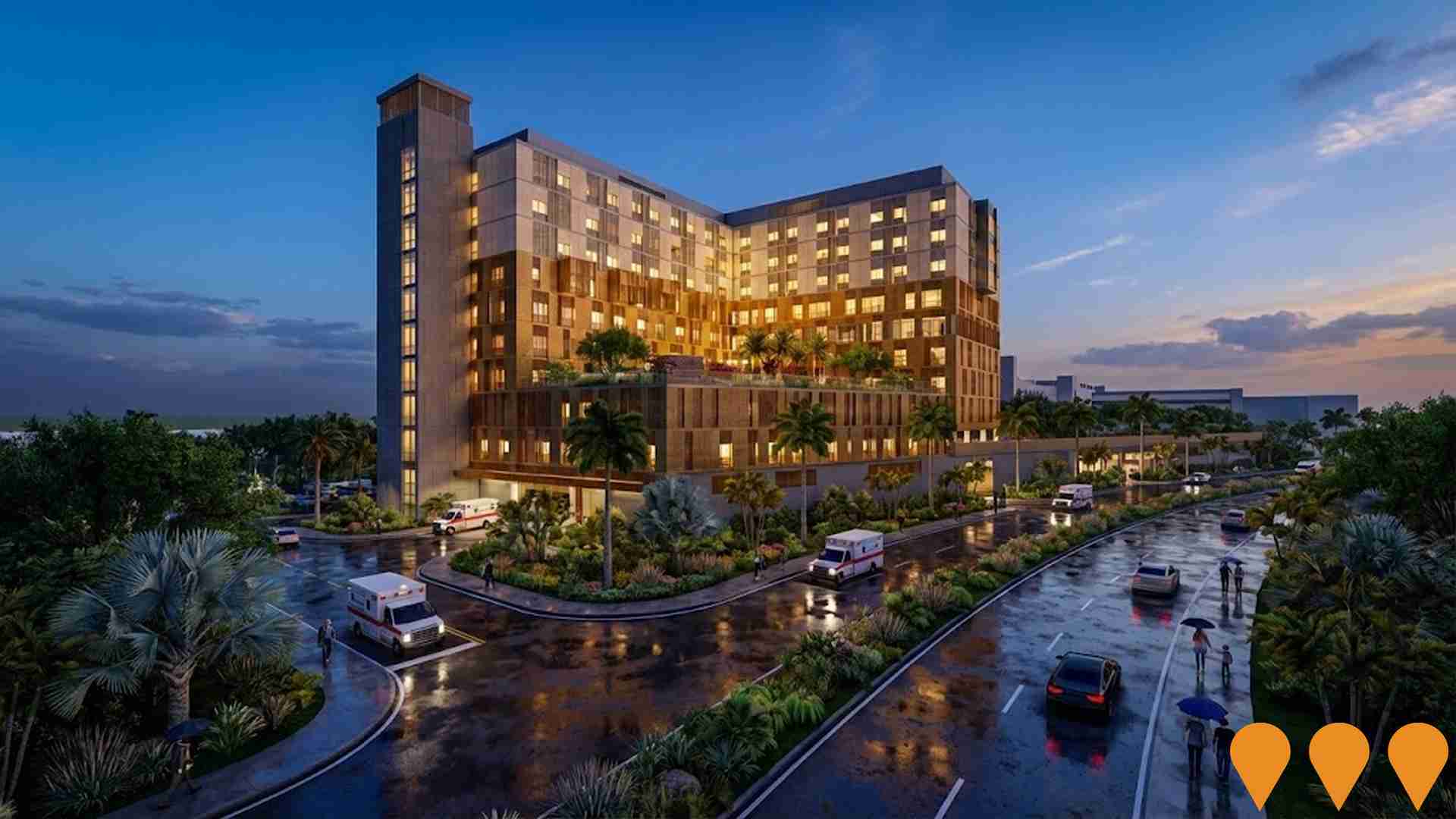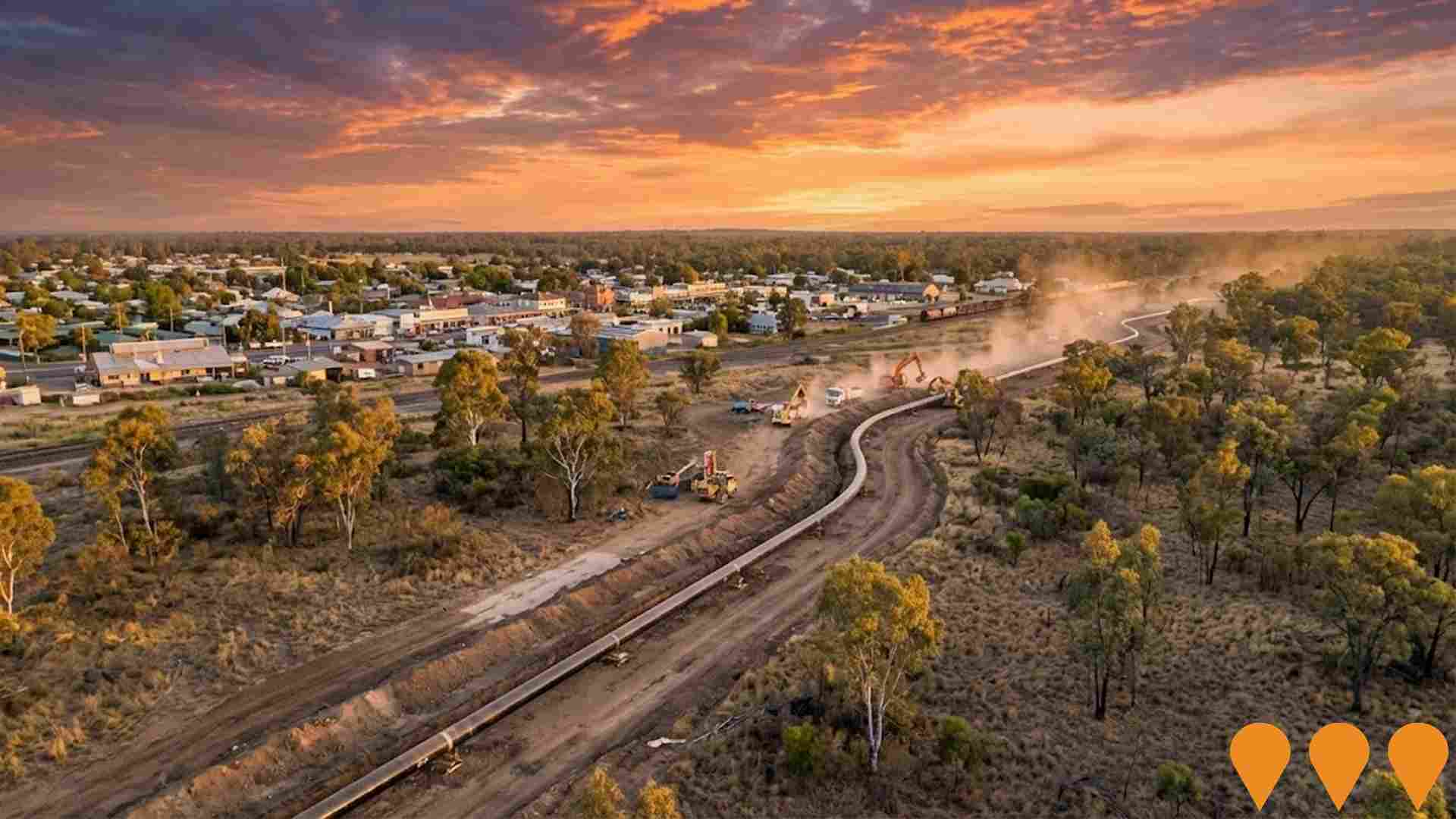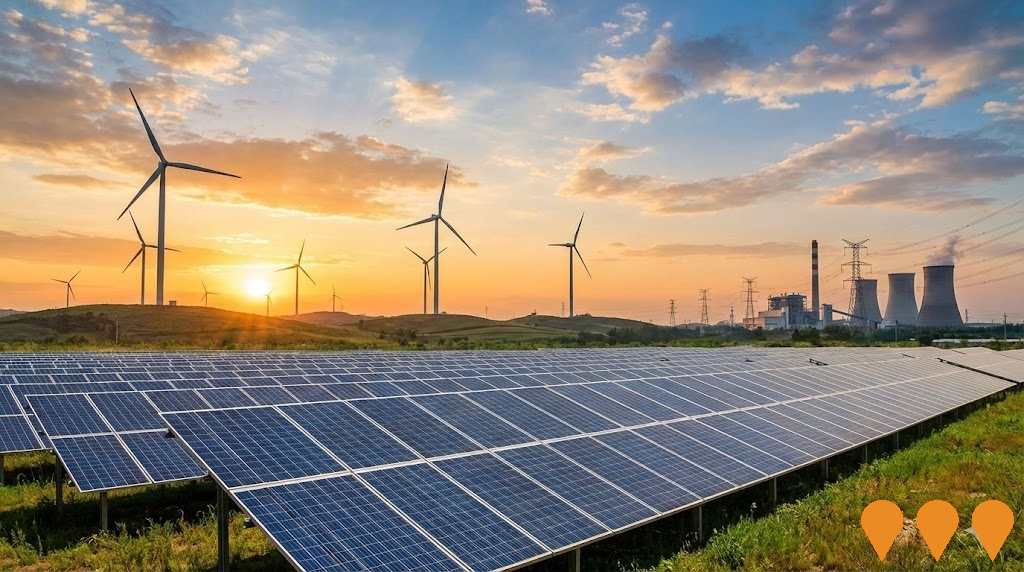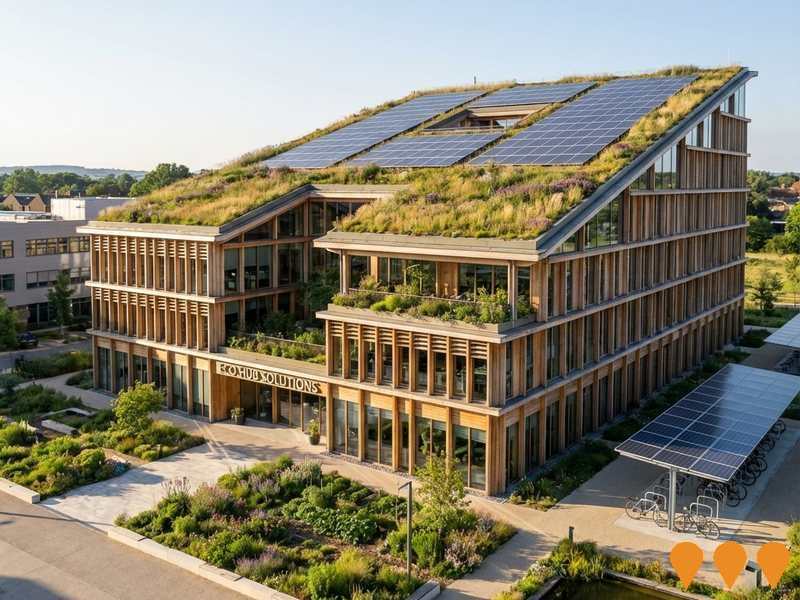Chart Color Schemes
est. as @ -- *
ABS ERP | -- people | --
2021 Census | -- people
Sales Activity
Curious about local property values? Filter the chart to assess the volume and appreciation (including resales) trends and regional comparisons, or scroll to the map below view this information at an individual property level.
Find a Recent Sale
Sales Detail
Population
An assessment of population growth drivers in Miles - Wandoan reveals an overall ranking slightly below national averages considering recent, and medium term trends
Miles-Wandoan's population was 4,522 as of Aug 2025, according to AreaSearch's analysis. This reflected an increase of 342 people since the 2021 Census, which reported a population of 4,180. The change was inferred from the estimated resident population of 4,357 in June 2024 and an additional 135 validated new addresses since the Census date. This resulted in a density ratio of 0.40 persons per square kilometer. Miles-Wandoan's growth of 8.2% since the 2021 census exceeded the SA3 area (4.6%) and the SA4 region, marking it as a growth leader. Natural growth contributed approximately 60.4% of overall population gains during recent periods, with all drivers including overseas migration and interstate migration being positive factors.
AreaSearch adopted ABS/Geoscience Australia projections for each SA2 area released in 2024 with a base year of 2022. For areas not covered by this data and years post-2032, Queensland State Government's SA2 area projections released in 2023 based on 2021 data were adopted. These state projections did not provide age category splits, so AreaSearch applied proportional growth weightings in line with the ABS Greater Capital Region projections released in 2023 based on 2022 data for each age cohort. Looking ahead, lower quartile growth of regional areas across the nation was anticipated, with Miles-Wandoan expected to grow by 136 persons to 2041 based on the latest population numbers, resulting in a reduction of 0.6% over the 17 years.
Frequently Asked Questions - Population
Development
Residential development activity is lower than average in Miles - Wandoan according to AreaSearch's national comparison of local real estate markets
Miles-Wandoan has received approximately five dwelling approvals annually over the past five financial years, totalling 29 homes. As of FY-26, two approvals have been recorded. On average, about 5.5 new residents arrive per year for each dwelling constructed between FY-21 and FY-25. This suggests supply is lagging demand, potentially leading to heightened buyer competition and pricing pressures.
The average construction value of new properties is $301,000, which is below regional norms, indicating more affordable housing options. In terms of commercial development, $27.6 million in approvals have been registered this financial year, demonstrating moderate levels of activity. Compared to the Rest of Qld, Miles-Wandoan shows 16.0% lower construction activity per person. Nationally, it ranks among the 26th percentile of areas assessed, suggesting limited buyer options and strengthening demand for established properties. Recent construction comprises 67.0% detached dwellings and 33.0% attached dwellings, marking a shift from existing housing patterns that are currently 88.0% houses.
This change could indicate diminishing developable land availability and responses to evolving lifestyle preferences and affordability needs. The estimated population per dwelling approval in the area is 1260 people, reflecting its quiet development environment. With projected stability or decline in population, Miles-Wandoan may experience reduced housing demand pressures, benefiting potential buyers.
Frequently Asked Questions - Development
Infrastructure
Miles - Wandoan has limited levels of nearby infrastructure activity, ranking in the 15thth percentile nationally
Changes to local infrastructure significantly impact an area's performance. AreaSearch has identified nine projects likely affecting the region. Notable ones are Arrow Energy Surat Gas Project North, Arrow Energy Surat Gas Project, Bungaban Renewable Energy Project, and Western Downs Green Power Hub. The following details those most relevant.
Professional plan users can use the search below to filter and access additional projects.
INFRASTRUCTURE SEARCH
 Denotes AI-based impression for illustrative purposes only, not to be taken as definitive under any circumstances. Please follow links and conduct other investigations from the project's source for actual imagery. Developers and project owners wishing us to use original imagery please Contact Us and we will do so.
Denotes AI-based impression for illustrative purposes only, not to be taken as definitive under any circumstances. Please follow links and conduct other investigations from the project's source for actual imagery. Developers and project owners wishing us to use original imagery please Contact Us and we will do so.
Frequently Asked Questions - Infrastructure
Santos GLNG Project
Large-scale coal seam gas to LNG project comprising upstream gas field development in the Surat and Bowen Basins, gas transmission pipelines, and a liquefied natural gas (LNG) plant on Curtis Island near Gladstone. The project has been operational since 2015 with ongoing drilling and field expansion activities.

Arrow Energy Surat Gas Project North
The Surat Gas Project North expansion involves drilling up to 450 new coal seam gas wells, construction of a new field compression station, gas and water gathering pipelines, and associated infrastructure across approximately 5,000 square kilometres in the northern Surat Basin. The project will deliver an additional 130 TJ/day of gas to domestic and export markets. Construction commenced in late 2024, with first gas expected in 2026 and full ramp-up by 2029.

Arrow Energy Surat Gas Project
Major coal seam gas to LNG project in the Surat Basin involving drilling of thousands of wells, construction of field compression stations, central processing facilities and pipelines to deliver gas to Shell-operated Curtis Island and Gladstone LNG facilities. Joint venture between Shell and PetroChina (50/50).

Wallumbilla Gas Supply Hub Upgrade Project
Major upgrade of the Wallumbilla Gas Supply Hub including new compression facilities (Wallumbilla Compressor Station Expansion), additional pipeline looping on the Queensland Gas Pipeline and Roma Brisbane Pipeline, and enhanced bi-directional flow capability to support east-coast and export gas market demands.

Building Future Hospitals Program
Queensland's flagship hospital infrastructure program delivering over 2,600 new and refurbished public hospital beds by 2031-32. Includes major expansions at Ipswich Hospital (Stage 2), Logan Hospital, Princess Alexandra Hospital, Townsville University Hospital, Gold Coast University Hospital and multiple new satellite hospitals and community health centres.

Bungaban Renewable Energy Project
A 1.4 GW wind farm with an associated large battery, about 40 km north east of Wandoan in Western Downs and Banana Shire. Developed by Windlab as part of the South Queensland Renewable Generation Hub. The project received State development approval in March-April 2025. Rio Tinto has signed a 25 year PPA for 80% of generation to help repower Gladstone operations. Powerlink is progressing the transmission connection (new substation and 275 kV double circuit line to Wandoan South). Target start of construction from late 2025 with first generation expected by 2029. Peak construction workforce ~1000 with ~30+ ongoing roles in operations.

Western Downs Green Power Hub
The Western Downs Green Power Hub is a major renewable energy project developed by Neoen Australia, comprising Australia's largest operating solar farm at 460 MWp (over 1 million panels, generating >1,080 GWh annually) and a co-located 540 MW / 1,080 MWh battery energy storage system in two equal stages. The solar farm has been fully operational since 2022. Battery Stage 1 (270 MW / 540 MWh) was completed and became operational in June 2025. Battery Stage 2 (270 MW / 540 MWh) is under construction following NTP in 2024, with operations expected in 2026. Located near Chinchilla with direct connection to Powerlink's Western Downs substation, the hub provides grid stability, clean energy under PPA with CleanCo Queensland, and community benefits including up to $100,000 annually for local initiatives.

Arrow Energy Surat Pipeline Project
The Surat Pipeline Project is part of Arrow Energy's larger Surat Gas Project, involving the construction and operation of pipelines and related infrastructure to transport coal seam gas from production fields in the Surat Basin to processing facilities and markets, supporting Queensland's energy needs.

Employment
The labour market in Miles - Wandoan shows considerable strength compared to most other Australian regions
Miles-Wandoan has a skilled workforce with diverse sector representation. As of June 2025, the unemployment rate is 3.2%.
Over the past year, employment growth was estimated at 4.6%. In Miles-Wandoan, 2,456 residents are in work, with an unemployment rate of 0.8% below Rest of Qld's rate of 3.9%. Workforce participation is 61.5%, compared to Rest of Qld's 59.1%. Leading employment industries among residents include agriculture, forestry & fishing, construction, and retail trade.
Agriculture, forestry & fishing has notably high concentration, with employment levels at 7.0 times the regional average. Health care & social assistance is under-represented, with only 7.5% of Miles-Wandoan's workforce compared to Rest of Qld's 16.1%. The ratio of 0.7 workers for each resident indicates above-normal local employment opportunities. Over a 12-month period ending June 2025, employment increased by 4.6%, labour force by 5.8%, causing the unemployment rate to rise by 1.1 percentage points. In contrast, Rest of Qld experienced employment growth of 1.8% and labour force growth of 2.0%, with a 0.2 percentage point rise in unemployment. Jobs and Skills Australia's national employment forecasts from May 2025 suggest potential future demand within Miles-Wandoan. These projections estimate national employment growth at 6.6% over five years and 13.7% over ten years, with varying rates between industry sectors. Applying these projections to Miles-Wandoan's employment mix suggests local growth of approximately 4.7% over five years and 10.7% over ten years, based on simple weighting extrapolation for illustrative purposes only.
Frequently Asked Questions - Employment
Income
Income figures position the area below 75% of locations analysed nationally by AreaSearch
AreaSearch's latest postcode level ATO data for financial year 2022 shows that Miles - Wandoan has an income below the national average. The median income is $47,173 and the average income stands at $51,467. This contrasts with Rest of Qld's figures where the median income is $50,780 and the average income is $64,844. Based on Wage Price Index growth of 13.99% since financial year 2022, current estimates would be approximately $53,773 (median) and $58,667 (average) as of September 2025. Census 2021 income data shows personal income ranks at the 44th percentile ($774 weekly), while household income sits at the 23rd percentile. Looking at income distribution, the predominant cohort spans 30.7% of locals (1,388 people) in the $1,500 - 2,999 category, reflecting patterns seen in the broader area where 31.7% similarly occupy this range. Housing costs are manageable with 90.3% retained, though disposable income sits below average at the 31st percentile.
Frequently Asked Questions - Income
Housing
Miles - Wandoan is characterized by a predominantly suburban housing profile, with above-average rates of outright home ownership
Dwelling structure in Miles-Wandoan, as evaluated at the latest Census, consisted of 87.8% houses and 12.2% other dwellings. In comparison, Non-Metro Qld had 90.3% houses and 9.7% other dwellings. Home ownership in Miles-Wandoan was 39.0%, with the remainder mortgaged (21.1%) or rented (39.9%). The median monthly mortgage repayment was $1,018, lower than Non-Metro Qld's average of $1,300 and significantly below the national average of $1,863. The median weekly rent figure in Miles-Wandoan was $200, substantially lower than Non-Metro Qld's $230 and the national figure of $375.
Frequently Asked Questions - Housing
Household Composition
Miles - Wandoan features high concentrations of lone person households, with a lower-than-average median household size
Family households constitute 66.6% of all households, including 25.0% couples with children, 30.9% couples without children, and 9.5% single parent families. Non-family households make up the remaining 33.4%, with lone person households at 30.2% and group households comprising 2.9%. The median household size is 2.4 people, which is smaller than the Rest of Qld average of 2.5.
Frequently Asked Questions - Households
Local Schools & Education
Miles - Wandoan faces educational challenges, with performance metrics placing it in the bottom quartile of areas assessed nationally
The area's university qualification rate is 16.3%, significantly lower than the Australian average of 30.4%. This presents both a challenge and an opportunity for targeted educational initiatives. Bachelor degrees are most prevalent at 14.2%, followed by graduate diplomas (1.1%) and postgraduate qualifications (1.0%). Trade and technical skills are prominent, with 40.6% of residents aged 15+ holding vocational credentials - advanced diplomas (10.0%) and certificates (30.6%).
Educational participation is high at 31.3%, including 13.7% in primary education, 8.4% in secondary education, and 2.8% pursuing tertiary education. A network of eight schools operates within Miles - Wandoan, educating approximately 588 students. The educational mix includes six primary, one secondary, and one K-12 school.
Frequently Asked Questions - Education
Schools Detail
Nearby Services & Amenities
Transport
No public transport data available for this catchment area.
Frequently Asked Questions - Transport
Transport Stops Detail
Health
Health performance in Miles - Wandoan is lower than average with prevalence of common health conditions notable across both younger and older age cohorts
Miles-Wandoan faces significant health challenges, with common health conditions prevalent among both younger and older age cohorts. The rate of private health cover is extremely low at approximately 46% of the total population (~2098 people), compared to 49.2% across the rest of Queensland. Nationally, this figure stands at 55.3%.
Asthma and arthritis are the most common medical conditions in the area, impacting 8.6 and 8.5% of residents respectively. Meanwhile, 67.7% of residents declare themselves completely clear of medical ailments, compared to 67.6% across the rest of Queensland. The area has 18.5% of residents aged 65 and over (838 people). Health outcomes among seniors present some challenges, broadly in line with the general population's health profile.
Frequently Asked Questions - Health
Cultural Diversity
Miles - Wandoan is considerably less culturally diverse than average when assessed alongside AreaSearch's national rankings for language and cultural background related metrics
Miles-Wandoan had a cultural diversity index below the average, with 82.3% of its population being Australian citizens, 90.6% born in Australia, and 94.5% speaking only English at home. Christianity was the predominant religion in Miles-Wandoan, accounting for 65.6%, compared to 64.6% across the rest of Queensland. The top three ancestry groups were Australian (35.4%), English (28.5%), and Irish (8.1%).
Notably, German ancestry was slightly higher at 5.7% compared to the regional average of 5.3%. Australian Aboriginal ancestry was lower at 4.9% than the regional average of 6.7%, while Filipino ancestry was also lower at 1.3% compared to 1.0% regionally.
Frequently Asked Questions - Diversity
Age
Miles - Wandoan's population is slightly younger than the national pattern
The median age in Miles-Wandoan is 38 years, which is slightly below Rest of Queensland's average of 41 but aligns with Australia's median age of 38 years. The 25-34 age group comprises 16.6% of the population in Miles-Wandoan, higher than Rest of Queensland's percentage. Conversely, the 45-54 cohort makes up 10.5%, which is lower compared to Rest of Queensland. According to data from the 2021 Census, the 25-34 age group has increased from 15.2% to 16.6% of Miles-Wandoan's population, while the 45-54 cohort has decreased from 12.5% to 10.5%. Population forecasts for 2041 suggest significant demographic changes in Miles-Wandoan. Notably, the 25-34 age group is projected to grow by 15 people (from 751 to 864), while the 45-54 and 5-14 cohorts are expected to experience population declines.




